The case for social innovation, viewed though the decline of movie theatres
Social innovation enhances competitiveness, taps into the collective wisdom, and makes a difference for the common good. What could this mean practically for a challenged industry? Based on some recent reports about the movie industry, I decided to take a look at how social innovation might apply to a popular but changing pastime.
The case for innovation

It pays to innovate. The 2014 Australian Innovation System Report states that 42% of Australian businesses engaged in innovative activities. These innovative companies accounted for 70% of the economy’s employment, capital expenditure and business income.
Compared to businesses that do not innovate, these innovative businesses were also:
- 31% more likely to increase income and 46% more likely to report increased profitability;
- twice as likely to export and five times more likely to increase the number of export markets targeted;
- twice as likely to increase productivity, employment and training;
- three times more likely to increase investment in information and communications technology; and
- three times more likely to increase the range of goods and services offered.
Organisations that innovate do better commercially than those that don’t. The report highlighted four types of innovation, including: product innovation, process innovation, marketing innovation, and organisational innovation. All of these innovations require people, which brings to mind a type of innovation not explicitly highlighted in the report, that of social innovation.
Defining social innovation
The term “social innovation” can apply to a few schools of thought.
1. Innovation for the social good
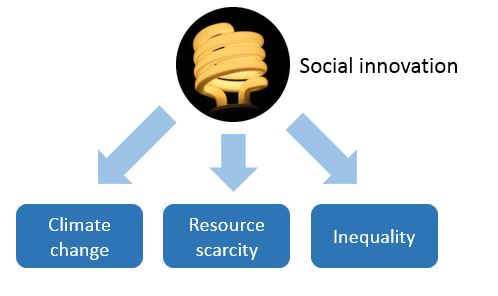
One way to consider social innovation is how the innovation is applied for the benefit of the greater good. Under this condition, social innovation is defined as being “motivated by the goal of meeting a social need and predominantly diffused through organizations whose primary purposes are social”. This definition usually focuses on resolving economic crisis and other global dilemmas such as climate change, energy and resource scarcity, and health and demographic imbalances, which are becoming more urgent and require rapid resolution.
The separate focus on social innovation is needed to address what some describe as the illusion that innovation for economic gain will somehow trickle down to address social woes. The state of the world demonstrates that this may not be the case. It appears that society focuses on pervasive social challenges only when social issues hinder economic gain. Social innovation under this definition becomes prominent when the pressure from the social needs of the many inhibit the inclination for profit or power of the few.
2. Innovation from the social network
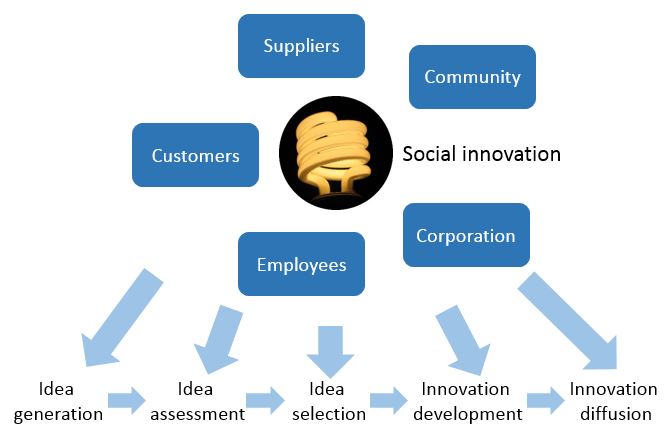
Another way of looking at social innovation is to tap into social networks to better develop and distribute innovation. New business models are being reinvented. Concepts such as user-led design, collaborative social design, and crowdfunding involves everyone who has a vested interest to contribute their voice.
We see examples of this social innovation in the form of “hack-a-thons” that get those with ideas together with customers who are recipients of the ideas, financiers who can fund the ideas, business leaders who can commercialise the ideas, and programmers who can develop the ideas. These are similar to the idea of a “living lab”, a concept that embraces the context in which the innovation will be applied and is particularly effective in delivering innovation in communities.
These collaborations are necessary because the success and failure of innovation is highly dependent on the social system in which it is released. Getting the input from those that will be impacted by and benefit from the innovation ensures the innovation has a greater likelihood of success.
The nature of the engagement is critical if this benefit is to be realised. For social innovation to be successful, those at the top need to let go of control of their idea of the end goal, allowing it to be developed through a shared vision. The role of leadership in this form of social innovation is to create the space and framework that allows the wisdom from the network to emerge.
3. Innovation that involves people

A third way of viewing social innovation is where the innovation itself involves people as primary actors.
A few examples include:
- Crowd-designed products such as Domino’s Pizza’s Pizza Mogul, that allows people to create and receive funds from their pizza designs;
- distributed computing projects such as SETI that searches for extra-terrestrial life through using the computing power from anyone who volunteers their computer to connect to the project;
- Social markets such as AirBNB that connects people wanting a place to stay with people who have a place to offer; and
- Community facilitation including any or the range of social applications like Facebook, Instagram, SnapChat, Twitter, Tinder, LinkedIn, or Meetup, all of which are designed to connect people around a certain function or domain.
In these examples the participants form the innovation itself. There is an unseen connection between each of these participants, a form of grease between the cogs of the innovation system. If that connection is only individual self-interest, than the system is at risk of becoming imbalanced and fragmenting. A stronger, more resilient connection is social capital, or “the goodwill available to individuals or Groups”.
Consider the reaction to any brand when users feel their privacy is violated or that they are being taken advantage of. If the goodwill of participants breaks down, the social system deteriorates. A social innovation cannot be sustained simply by the technology or function that brought the people together. There must be consistent, renewed social capital in the form of community to maintain the connection.
Testing social innovation on the decline of movie theatres
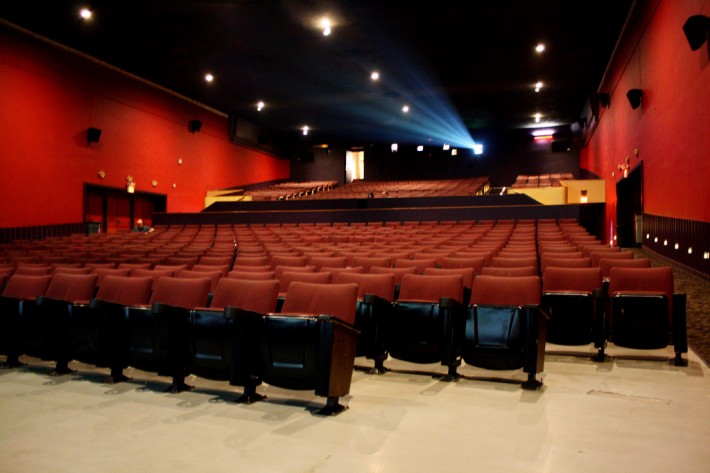
I have been doing some work recently reviewing corporate innovation programs. I was in this headspace when I read about how the movie theatre industry is declining and thought I would use them as a case study on what social innovation could look like.
An article in a recent Australian Financial review highlighted that North American box office receipts fell 5% in 2014 from the previous year. The prime demographic of 12 to 24 year olds, representing almost a third of ticket sales, saw 8.4% fewer films at cinemas than 2013. This is a trend that has continued from previous years. Financial impacts are compounded by economic pressures that have ticket prices increasing at a slow rate that is below inflation.
The trend in movie theatres is towards more screens, new technology, and improved service experiences. The average screens per theatre was 12 in 2013 for the top five chains in the United States, compared to 3 screens per theatre in 1988. More screens means greater resiliency against low-performing movies. It does not matter what you see, just so long as you buy a ticket and walk through the door.
Theatres are also continually updating to keep up with technology. 3D, HD, and Dolby Surround Sound require new equipment and new layouts to take advantage of the technologies. These experiences are supported by VIP lounge seating and improved personal service.
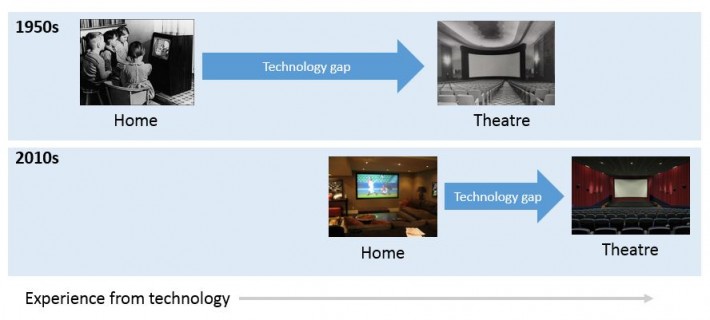
Theatres are investing in these improvements not to compete with other entertainment options as much as to compete with other distribution channels offering the same service. In other words, they are competing with your living room.
Fifty years ago, the gap between your home and the theatre was a 12-inch black and white tube versus a large theatre screen. Now that gap is shrinking at an increasing rate. A 50-inch TV costs less than $500 and a surround system around $250. Movies are also available sooner with quicker release to video and digital downloads, legal or otherwise.
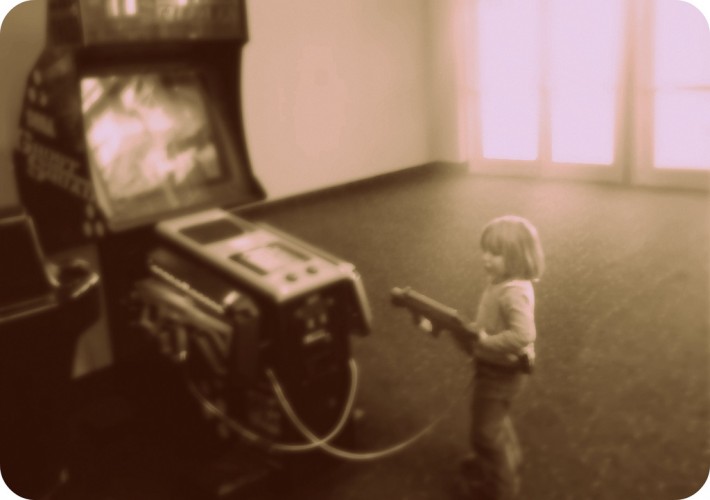
We saw a similar situation play out in the decline (demise?) of video game arcades. Some argue their decline was more related to social issues with youth gathering in one area, but the influence of home gaming consoles that provide a similar experience was a significant factor.
The gap between what you could experience in the arcade and what you could get at home continued to decrease, even as the technology cost of providing that experience increased in the arcade and decreased at home. The arcades that remain are now very different to what I recall in the golden era of the 70s and 80s. Games in modern arcades tend to have a full physical experience such as sitting in a car seat, shooting a physical gun, or dancing on a dance pad. They also tend to cater for multiple players at the same time, encouraging physical competition.
Differentiating through the social experience
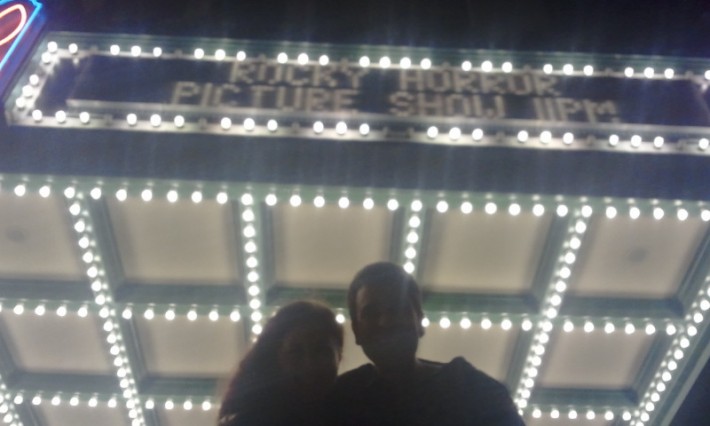
I don’t think movie theatres are going to disappear overnight and some analysts are predicting a return to limited growth in 2016 as the industry stabilises. Looking at overall industry numbers hides the true impact of the rationalisation. Those most at risk in the movie industry are smaller multiplexes or miniplexes with 10 or fewer screens. One analysis from 2013 warned that around 1,000 of these theatres are at risk of failing, or 20% of the total venues in the US and Canada.
These smaller players find it difficult to compete on traditional innovation platforms. They are unable to go head-to-head with upgrades for advancing digital technology, weathering reduced revenue from declining admission per capita, securing financing for prime locations, and positioning with large chains for combined theatre and restaurants. Rather than playing the same game, social innovation may offer opportunities to change the rules or change the game.
My experience in the film industry is limited to a few years supporting the online ordering platform for the local film festival. However, I have been socialising the notion of social innovation with a few of my friends, family, peers and colleagues. Here are a few ideas we came up with to leverage the existing strengths and tap into all three perspectives of social innovation:
- Create space for the cult movie experience
By definition, cult films are fringe but appeal to a specific community. Examples include the surprisingly popular but awful The Room and the Rocky Horror Picture Show which inspires dressing up, sing-alongs, and props. How can we make the space for these experiences and allow the community to create the cult experience relevant to them? - Crowdsource the movie(s)
There have been a few times when I have gone to see a movie and we are the only ones in the theatre. This happens particularly at the end of a movie’s run. If you know you will have an empty theatre, how about reserving a day a month and let people know they can pick the film. Whoever gets the most people to commit gets the theatre. Perhaps extend this to a full day line-up to let people program their own film festival. - Create a role for a movie broker
Movie theatre attendance is dominated by what are referred to as “frequent movie goers”. This segment watch at least one movie per month and represent 10% of the population, but purchase half of all tickets sold. In addition to existing loyalty programs, is there space to turn some of these into “movie brokers”? These individuals would get a discount for every person they brought with them. Eventually, they could even get paid for getting others into the theatre. This is similar to Domino’s Pizza Mogul project that gives a person money if enough people purchase their pizza design. - Create space before and after
The movie theatre experience is a bit of a paradox, in that you are sitting in a room full of strangers having a shared experience where interaction is discouraged. This collective solitary experience is ideal for some, with one study on movie-going experience saying “most interviewees were at best ambivalent and at worst dismissive of their fellow theatre-goers, often regarding them as distractions which forced them to ‘zone-out’”. However, the paper also noted that this response was not aligned with other research that said sharing and reflecting were important to the movie experience. Perhaps there is an opportunity to cater for those who do value the interaction by creating a space to mingle and engage. Examples could include trivia, networking drinks, and themed food events related to the film. - Facilitate interaction through the entire transaction process
What if for select films you could see the demographics of those attending and perhaps know something about them? What if when you purchased a ticket you could leave a comment that was visible, facilitating social interaction from the start of the experience? What if this interaction continued after the film? All of this is possible through channels such as Facebook, but perhaps there is a way to develop a community space specific to the theatre.
The intent here is not to come up with the idea, but to use movie theatres as an example to prompt further conversation and tap into all three aspects of social innovation:
- First, the ideas involve the people themselves and can build and leverage social capital or goodwill in the community.
- Second, the ideas can involve the people to help determine what the end outcome looks like.
- Third, the innovation improves humanity. Theatres can act as what is referred to as a “third space”, a safe place that is not work or home that allows community to happen. These places have the potential to build healthy, resilient communities.
Be social
I was sharing this concept with a colleague who told of her experience growing up in a small rural town. The movie theatre for her was more than the movie, it was an event, a part of the community fabric where people came together. She expressed how we have lost this connection, and that we need to circle back to regain the community aspect of coming together.
She experienced some of the magic again when she attended a themed movie at a local boutique art house cinema. She shared with excitement how she and her partner got dressed up for the classic movie, which included an intermission and high tea. She felt a part of something bigger and was able to chat with people around a common theme. She only wished there were more people her age in attendance and perhaps other ways to continue the connection with those around her.
So what do you think? Would you engage in a movie theatre social innovation experiment?
What about for where you work? We know innovation in all forms makes for better outcomes in business and community. How could social innovation be applied in your situation?
- Is the social capital sufficient to build resiliency in the ideas that are implemented?
- How can the collective wisdom be tapped of those who have a stake in what you do?
- Are there ideas where people can come together for organisational outcomes as well as social good?
In the spirit of being social, feel free to comment below and share as you feel it adds value.

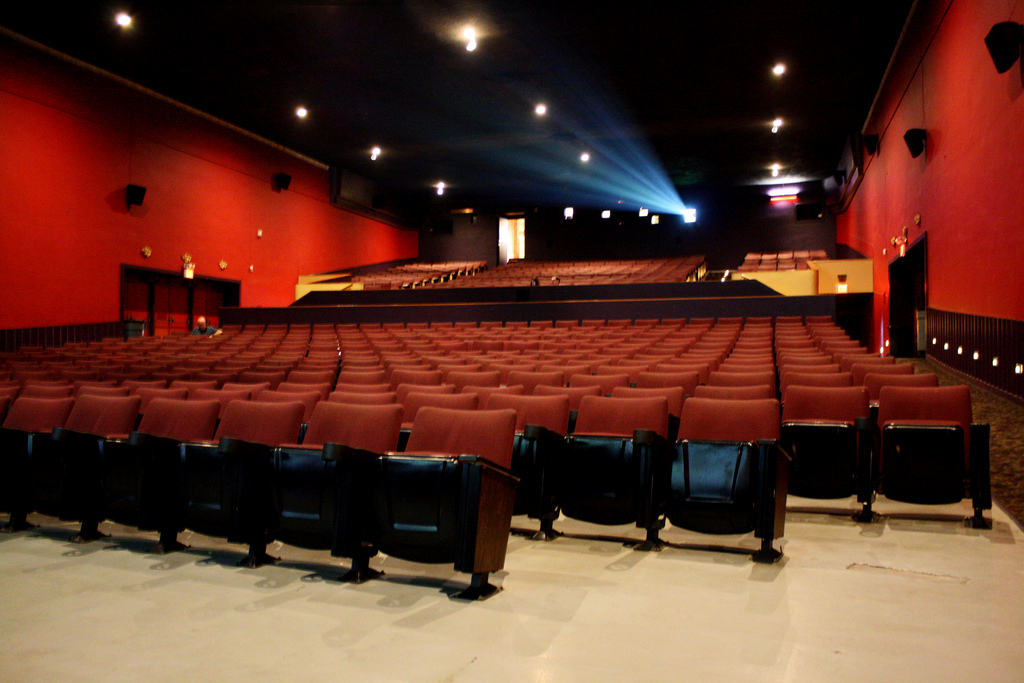
Nice insights and the comparative thinking around innovation is thought provoking. The innovation is being applied at a local drive in theatre near my home where they organise monthly double features where the kids movie is first and then there is an intermission before the adults movie. They have “car” rates of $10 so it’s even a cost savings to have extra kids along and then they all snuggle up for sleep while the parents watch the late show. The community support was evident when they needed to upgrade to a digital projector (to stay in business) and they a) crowdsourced the funds, then thanked the community by offering a free movie night to contributors.
It’s a family run business that also has a learning café where youth workers can get experience in the hospitality sector and patrons get a well priced meal (not the regular gouging in a theatre). You know that you are supporting the community!
Great example, Mark! Drive-ins are a niche that rely on community to survive.